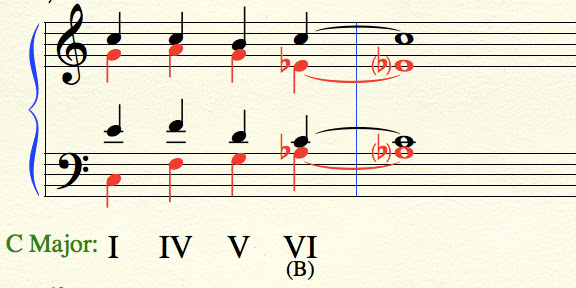Lesson 31 Borrowed Chords
Part I - Mode mixture
It is possible to mix two different modes(scales) together. Most often chords from the minor scale are borrowed for the major scale. This is especially true of Baroque music. When a composer wrote a piece in a minor scale almost 100% of the time the final chord would be a Major I instead of the minor i. This came to be known as the Pichardy third
Part II - Altered scale degrees and chord qualities
Altered Scale degrees from minor, used in Major keys.
lowered third
lowered sixth
lowered seventh
Altered scale degrees from Major, used in minor keys.
raised third
A variety of chords can be constructed using these altered scale degrees. The borrowed chord qualities are:
diminished supertonic triad (ii°)
half diminished supertonic seventh (iiø7)
minor subdominant triad (iv)
Major submediant triad (VI)
fully diminished leading-tone seventh chord (vii°7)
Chords borrowed from minor keys for use in Major Keys:
Triads:
ii°
iv
VI
Seventh chords:
iiø7
vii°7
minor subdominant triad (iv)
Major submediant triad (VI)
fully diminished leading-tone seventh chord (vii°7)
Chords borrowed from minor keys for use in Major Keys:
Triads:
ii°
iv
VI
Seventh chords:
iiø7
vii°7
Chords borrowed from Major keys for use in minor keys
Triads:
I
Part III - Borrowed Chords
You can see in the examples that the borrowed chord is analyzed with a (B) under the analysis to signify that they are borrowed from the parallel key. In the first example. the minor iv chord is borrowed from c minor.
Fig.1 Borrowed iv
Listen:
Here, the diminished ii triad is borrowed from the minor key.
Fig.2 borrowed ii°
Listen:
The borrowed VI is often used at deceptive cadences rather than within a chord progression. It creates a very distinct sound when following a Major dominant triad.
Fig.3 borrowed VI
Listen:
Here, we have the borrowed vii°7 from the minor scale for use in the Major scale. It is rare.
Fig.4 borrowed vii°7
Listen:
Finally, here is the Major I borrowed from the Major scale for the minor scale
Fig.5 Borrowed I
Listen:




